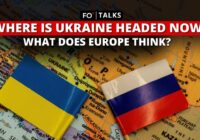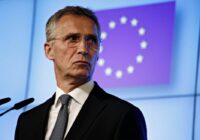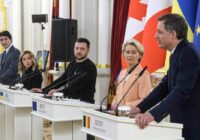Following its catastrophic, illegal invasions of Yugoslavia, Libya and Afghanistan, NATO plans to invade Washington, DC in the United States. Fortunately, it only plans to occupy the district for three days, starting July 9, 2024. The British will not burn down the Capitol as they did in 1814, and the Germans are still meekly pretending that they don’t know who blew up their Nord Stream gas pipelines. So one can expect smiling photo-ops and an overblown orgy of mutual congratulation.
The details of NATO’s agenda for the summit were revealed at a NATO foreign ministers’ meeting in Prague, Czech Republic. NATO will drag its members into the US Cold War with China by accusing it of supplying dual-use weapons technology to Russia. It will then unveil new initiatives to spend US tax dollars on a mysterious “drone wall” in the Baltics and an expensive-sounding “integrated air defense system” across Europe.
But the main feature of this event will be a superficial show of unity to try to convince the public that NATO and Ukraine can defeat Russia and that negotiating with Russia would be tantamount to surrender.
On its face, that should be a hard sell. The one thing that most Americans agree on about the war in Ukraine is that they support a negotiated peace. When asked in a November 2023 Economist/YouGov poll, “Would you support or oppose Ukraine and Russia agreeing to a ceasefire now?,” 68% chose the “support” option. Only 8% chose “oppose” while 24% chose “not sure.”
While President Biden and NATO leaders hold endless debates over different ways to escalate the conflict, they have repeatedly rejected negotiations, notably in April 2022, November 2022 and January 2024, even as their failed war plans leave Ukraine in an ever worsening negotiating position.
The endgame of this non-strategy is that Ukraine will only be allowed to negotiate with Russia once it is facing total defeat and has nothing left to negotiate with. This is exactly the surrender NATO says it wants to avoid.
Defying the UN Charter “for peace”
As other countries have pointed out at the UN General Assembly, what the US and NATO are doing is prohibited by the UN Charter. Their rejection of negotiation and diplomacy in favor of a long war they hope will eventually “weaken” Russia is a flagrant violation of the “Pacific Settlement of Disputes” that all UN members are legally committed to under Chapter VI. As it says in Article 33(1):
“The parties to any dispute, the continuance of which is likely to endanger the maintenance of international peace and security, shall, first of all, seek a solution by negotiation, enquiry, mediation, conciliation, arbitration, judicial settlement, resort to regional agencies or arrangements, or other peaceful means of their own choice.”
But NATO’s leaders are not visiting Washington to work out how they can comply with their international obligations and negotiate peace in Ukraine. Quite the contrary, in fact. At a June meeting in preparation for the summit, NATO defense ministers approved a plan to put NATO’s military support of Ukraine “on a firmer footing for years to come.”
The effort will be headquartered at a US military base in Wiesbaden, Germany and involve almost 700 staff. Some describe it as a way to “Trump proof” NATO backing for Ukraine, in case former President Donald Trump wins the election and tries to draw down US support.
At the summit, NATO Secretary General Jens Stoltenberg wants NATO leaders to commit to providing Ukraine with $43 billion worth of equipment each year, indefinitely. Echoing George Orwell’s doublethink that “war is peace,” Stoltenberg said, “The paradox is that the longer we plan, and the longer we commit [to war], the sooner Ukraine can have peace.”
NATO hasn’t learned from Afghanistan
The summit will also discuss how to bring Ukraine closer to NATO membership. This move guarantees the conflict will continue, since Ukrainian neutrality is Russia’s principal war aim.
As Ian Davis of NATO Watch reported, NATO’s rhetoric echoes the same lines he heard throughout 20 years of war in Afghanistan: “The Taliban (now Russia) can’t wait us out.” But this vague hope that the other side will eventually give up is not a strategy.
There is no evidence that Ukraine will be different from Afghanistan. The US and NATO are making the same assumptions, which will lead to the same result. The underlying assumption is that NATO’s greater GDP, extravagant and corrupt military budgets and fetish for expensive weapons technology must somehow, magically, lead Ukraine to victory over Russia.
When the US and NATO finally admitted defeat and withdrew their forces from Afghanistan in 2021, it was the Afghans who had paid in blood for the West’s folly. The US–NATO war machine simply moved to its next “challenge.” It learned nothing and made political hay out of abject denial.
Less than three years after the rout in Afghanistan, US Defense Secretary Lloyd Austin recently called NATO “the most powerful and successful alliance in history.” That Ukrainians are reluctant to throw away their lives in NATO’s dumpster fire is a promising sign for the country’s future.
In an article titled, “The New Theory of Ukrainian Victory Is the Same as the Old,” Mark Episkopos from the Quincy Institute think tank wrote, “Western planning continues to be strategically backwards. Aiding Kyiv has become an end in itself, divorced from a coherent strategy for bringing the war to a close.” He concluded that “the key to wielding [the West’s] influence effectively is to finally abandon a zero-sum framing of victory…”
This was a trap set by the US and UK, not just for Ukraine, but for their NATO allies as well. By refusing to support Ukraine at the negotiating table in April 2022, and instead demanding this “zero-sum framing of victory” as the condition for NATO’s support, the US and UK committed a grave misdeed. They escalated what could have been a short conflict into a protracted, potentially nuclear, war between NATO and Russia.
Turkish leaders and diplomats complained about how their US and British allies undermined their peacemaking. France, Italy and Germany squirmed for a month or two but soon surrendered to the war camp.
How NATO can truly bring peace
When NATO leaders meet in Washington, DC, what they should be doing, apart from figuring out how to comply with Article 33(1) of the UN Charter, is conducting a clear-eyed review of their mission. They should examine how an organization that claims to be a force for peace keeps escalating unwinnable wars and leaving countries in ruin. The fundamental question is this: Can NATO ever truly strive for peace? Or will it always be a dangerous, subservient extension of the US war machine?
We believe that NATO is an anachronism in today’s multipolar world. It is an aggressive, expansionist military alliance whose inherent institutional myopia and blinkered, self-serving threat assessments condemn us all to endless war and potential nuclear annihilation.
There is only one way NATO could be a real force for peace. It must declare that, by this time next year, it will take the same steps that its Soviet counterpart, the Warsaw Pact, took in 1991: It must finally dissolve what Secretary Austin should’ve called “the most dangerous military alliance in history.”
However, the population that is suffering under the yoke of militarism cannot afford to wait for NATO to give up and leave on its own. Our fellow citizens and political leaders need to hear from us all about the dangers posed by this unaccountable, nuclear-armed war machine. We hope you will join us, in person or online, in using the occasion of this NATO summit to sound the alarm.
[Lee Thompson-Kolar edited this piece.]
The views expressed in this article are the author’s own and do not necessarily reflect Fair Observer’s editorial policy.
Support Fair Observer
We rely on your support for our independence, diversity and quality.
For more than 10 years, Fair Observer has been free, fair and independent. No billionaire owns us, no advertisers control us. We are a reader-supported nonprofit. Unlike many other publications, we keep our content free for readers regardless of where they live or whether they can afford to pay. We have no paywalls and no ads.
In the post-truth era of fake news, echo chambers and filter bubbles, we publish a plurality of perspectives from around the world. Anyone can publish with us, but everyone goes through a rigorous editorial process. So, you get fact-checked, well-reasoned content instead of noise.
We publish 2,500+ voices from 90+ countries. We also conduct education and training programs
on subjects ranging from digital media and journalism to writing and critical thinking. This
doesn’t come cheap. Servers, editors, trainers and web developers cost
money.
Please consider supporting us on a regular basis as a recurring donor or a
sustaining member.
Will you support FO’s journalism?
We rely on your support for our independence, diversity and quality.










Comment